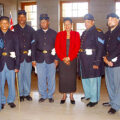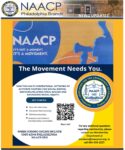By Renée S. Gordon
The major cause of the Civil War was the institution of slavery and the precursors to that great struggle were played out in a variety of ways, the thriving Underground Railroad (UGRR), Harper’s Ferry, the Christiana Riot and with a dedicated cast of characters including, Douglass, Brown and Thaddeus Stevens. The firing on Fort Sumter is considered the official opening volley of the war just as Gettysburg is considered the beginning of the end for the Confederacy. Pennsylvania was pivotal at every step along the path and, because of its location as the first free state north of the Mason Dixon Line, certain regions were crucial to the cause of freedom.
Pennsylvania was second only to Ohio in the sheer number of UGRR routes that ran across the state. Franklin County, named in honor of Benjamin Franklin, is close to the Mason Dixon Line and, because of its mountainous terrain filled with woodlands and caves, contained one of the main UGRR routes. Located just off Rte. 81, at the border, sits an original limestone Mason Dixon Line Crown Stone, the traditional division between North and South. The 233-mile Line was originally established in the 18th-century because of a land dispute between the Penn and Calvert families over the border between Maryland and PA. www.explorefranklincountypa.com
Mercersburg, a few miles from the border, was the first northern UGRR entry point. By the early 1850s the town’s black population hovered around 20 percent and 88 of the men would join the Union, most in the 54th and 55th Massachusetts. Thirteen are buried in the city’s Mt. Zion Cemetery.
The next major stations on the route were located 15 miles north in Chambersburg, one of Central PA’s true gems. Native American tribes were the original occupants of Chambersburg, once known as “the Queen City of the Cumberland Valley,” and many of their paths were the foundation of our modern roads. They called the area Falling Spring in reference to a waterfall at the juncture of two creeks. In 1703 Benjamin Chambers settled there and harnessed the waterpower to establish two mills. The town was incorporated and designated the county seat in 1803.
There are several ways to tour this city, a three-hour self-guided driving tour or a self-paced walking tour, but all visits should begin at the Chambersburg Heritage Center with a 15-minute orientation video. The center provides an excellent historic overview. An 8-ft. gilded statue of Benjamin Franklin is in a window on the second level. He faces the interior of the center during the day and is rotated to watch the city at night.
Start your city tour in Memorial Square at the Memorial Fountain and a sculpture of a Union soldier facing south. The cast iron fountain was installed in 1878 to honor the 5,000 soldiers from the county who fought in the war. Throughout the years the memorial has undergone additions, deletions and restorations. During the 1994 restoration it was discovered that the soldier is actually several pieces welded together and that his coat buttons are authentic brass of the type used on Federal uniforms. R. E. Lee and A. P. Hill met in the square on June 26, 1863. As a result of this meeting Lee headed toward Gettysburg. A plaque memorializes the event.
During the summer of 1859 Isaac Smith rented an upstairs room in Mary Ritner’s Boarding House. Mary and her husband Abram purchased the home in 1849 for $500 and after his death in 1851 Mary turned it into a boarding house. It was purportedly an UGRR stop and so it is no wonder that Mr. Smith, also known as John Brown, would choose to stay there to strategize the raid on Harper’s Ferry along with his sons and his Secretary of War, John Kagi. The house was ideally located close to the Cumberland Valley Railroad Station and the Oakes Warehouse where he received weapons and stored them prior to moving them to Kennedy Farm. He claimed to be a mine owner to account for the number and weight of the shipments.
Call ahead for tours. There is a 10-minute film, “In the Footsteps of John Brown,” that provides context for the events.
Frederick Douglass visited Chambersburg in August of 1859 and was instantly recognized. When asked why he was there he replied that he had come to make a speech and he did indeed speak. His true reason was to meet with John Brown on August 19-21st in an old quarry where Brown attempted to recruit him. Douglass refused but Shields Green, his companion, joined Brown. A marker has been placed at the meeting site.
Ironically two doors from the boarding house lived a notorious slave catcher. The Logan House, a private residence in the area, was also the home of a slave catcher and the rings used to bind them can still be seen in the attic. The last slave auction in the state was held just south of town. The Old Franklin County Jail dates from 1818 and was in operation until 1971. It is a fine example of Georgian architecture and remains complete with cells and the gallows in the courtyard. The basement dungeon functioned as a station on the UGRR and John Cook, one of Brown’s conspirators was held here until he could be transported for trial.
On July 30, 1864 General John McCausland rode into town with 2800 southern troops and demanded that Chambersburg pay a ransom, $100,000 in gold or $500,000 in greenbacks, or be burned to the ground. The citizens were both unwilling to help finance the Confederate cause and without the funds. The soldiers burned the majority of the city, more than 500 buildings.
As a result of this tragedy the town was rebuilt in the late 1860s with Late Victorian architecture and Main Street is lovely. While touring note that each builder “signed” his work by creating a unique window design in the style known as Carpenter’s Art.
In May of 1863 Lee began marching the 72,000 men in the Army of Northern Virginia northward. On June 24th and 25th Lee’s army crossed the Potomac River and on the following two days the Army of the Potomac followed, all the while keeping Washington, DC to their right and the rebel forces on their left.
As the Confederates moved through Maryland and PA they lived off the land, sometimes seizing crops and property and sometimes paying in Confederate dollars much to the chagrin of the citizens. Blacks fled as the rebels advanced because, unequivocally, the most outrageous acts committed by the soldiers were a series of ongoing, organized slave raids that rounded up African Americans, both fugitive and free, and marched them south. Once there they were returned to owners or sold at auction.
The Battle of Gettysburg began on July 1, 1863, continued for three days and resulted in an estimated 52,000 casualties, the largest number of any battle of the war. The Union emerged victorious and it is credited with being the turning point of the war. On November 19, 1863 President Lincoln visited Gettysburg to deliver “a few appropriate remarks” at the dedication of the Soldiers’ National Cemetery. The Gettysburg Address, a mere 272 words, links the ideals of the American Revolution with the necessity of preserving the Union.
There is such rich history in Gettysburg that you not only need several days but several visits. Visitors can be overwhelmed so planning is essential and much of that can be done online. It is best to tour thematically and concentrate on one or two aspects of the city’s heritage at a time even though they overlap. The most obvious choices are the Battle of Gettysburg, the National Cemetery, the homefront, the African American presence, ghosts of Gettysburg, President Eisenhower, the Lincoln Trail and museums and sites. Fortunately brochures are available and they include detailed information, maps and guides. I strongly suggest that you either take an organized tour or hire a licensed professional battlefield guide. This is the absolute best way to understand the nuances of the events. www.gettysburgfoundation.org and www.ridethetrolley.com
Your first visit should always include a tour of the National Park and its more than 850 monuments. The majority of the monuments were erected between 1867 and 1917. I find the NY monuments, in general, to be the most elaborate and numerous. Fully 1/3 of the men who fought here were from NY and another third from PA. Pennsylvania has the largest and most elaborate monument. www.gettysburg.stonesentinels.com
The Gettysburg Hotel, across from a life-sized sculpture of Lincoln and the city’s best photo op, is a wonderfully historic structure with McClellan’s Tavern. This wonderful restaurant has great ambience, a 1797 mahogany bar and outstanding cuisine. www.hotelgettysburg.com
Reserve a room in the Farnsworth House Inn to complete a perfect visit. Built in 1810 it contains original walls, floors and rafters. During the battle a Confederate sharpshooter perched there and in the exterior wall more than 100 bullet holes are still visible. Ghost tours are offered as well as excellent meals in the tavern. It has been featured on both the History Channel and A&E. www.farnsworthhouseinn.com
I need not tell you that Gettysburg will be in the forefront of the Sesquicentennial commemoration with a palette of activities including reenactments of the three-day battle that expended over 7,000,000-tons of ammunition and resulted in stunning casualties. Information is currently available. www.gettysburg.travel
Robert E. Lee believed he could subdue the towns of Central PA and press on to win the Civil War but his movements were hampered at every turn. We can freely follow his trail and better understand and honor the commitment Abraham Lincoln made so long ago, “”that this nation under God shall have a new birth of freedom, and that government of the people, by the people, for the people shall not perish from the earth” www.visitpa.com
I wish you smooth and scholarly travels!
TRAVEL TIP: St. Louis’ Old Courthouse, site of the famous Dred Scott Case, is also the location of the opening event the city’s Civil War Sesquicentennial Event, a re-enactment of the Probate Court ordered slave sale of the estate of Pelagie Cherbennou. The National Black Tourism Network and the National Park Service in conjunction with several other organizations sponsor the event. Date: January 15, 2011 Time: 10:00 AM
















Leave a Comment